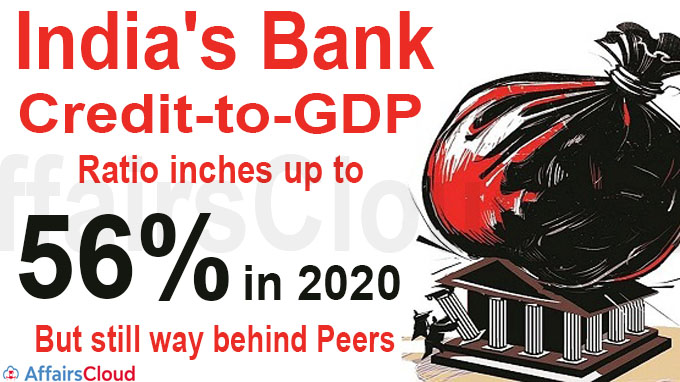
- The incremental credit growth in FY21 was about 5.56 percent (at Rs 109.51 lakh crore), which was the lowest recorded growth in 59 years (whereas in FY 1962 it was at 5.38 percent), in FY20, credit growth was at a 58-year-low at 6.14 percent.
- The total outstanding bank credit in 2020 stood at $1.52 trillion.
Improvement and Comparison:
i.Improvement: The country’s bank credit-to-GDP ratio was improved to 56.075% in 2020, from 52.7 percent in 2019, 52.4 percent in 2018, 53.6 percent in 2017. In 2016 it was about 59 percent and 64.8 percent (the five-year best) in 2015.
ii.Comparison:
- Even Though India’s bank credit-to-GDP 2020 ratio rose to a 5-year high, it is still the second-lowest among all its Asian peers, just half of the G20 economies’ ratio, and much lower than the emerging and advanced economies’ ratio of 135.5 percent and 88.7 percent.
- The ratio of other 4 BRICS (Brazil, Russia, India, China, and South Africa) members are China-161.75 percent, Russia-88.12 percent, Brazil-50.8 percent, and South Africa at a low 40.1 percent.
About bank credit-to-GDP ratio:
i.Bank credit growth, which is a key indicator of economic growth, is represented by the bank credit-to-GDP ratio.
ii.A higher credit-to-GDP ratio indicates the active participation of the banking sector in the real economy, in turn, the lower number represents the need for more formal credit.
Note – As per the economists and analysts, the Privatisation of state-run banks will lead to increased credit growth.
Positive Aspects:
i.Credit-to-GDP gap is the difference of the credit-to-GDP ratio from its long-term trend and it is a measure of the risks associated with higher lending to businesses and households’ businesses in a country over the long term.
ii.Positive Aspect: The lower bank credit-to-GDP ratio leads to the negative credit-to-GDP gap of – 5.7 percent (lowest in Asia) and it indicates the resilience of the economy to pay back debt.
Recent Related News:
On April 7, 2021, the International Monetary Fund(IMF) reported an increase in India’s debt to Gross Domestic Product (GDP) ratio from 74 percent (at the end of 2019) to 90 percent (at the end of 2020) during the COVID-19 period.
As per the National Housing Bank’s (NHB) report “The Trend and Progress of Housing in India” April 2021. The market shares of banks in individual housing loans(IHLs) has gone up to 67% in 2019-20 from 62% in 2017-18 and housing finance companies (HFCs) has come down to 33%( 2019-20) from 38% (2017-18).
About Bank for International Settlements (BIS):
It is an international financial institution owned by central banks, it fosters international monetary and financial cooperation, and serves as a bank for central banks. The Reserve Bank of India is also a member of BIS.
Establishment – 1930
Headquarters – Basel, Switzerland
Chairman – Jens Weidmann (Germany)
Members – 63 central banks and monetary authorities